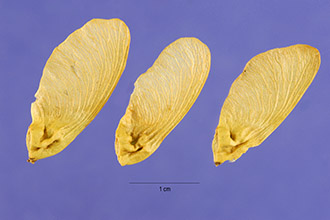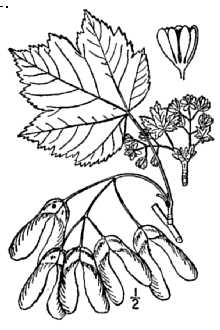Rocky Mountain Maple
Scientific Name: Acer glabrum Torr.

| General Information | |
|---|---|
| Usda Symbol | ACGL |
| Group | Dicot |
| Life Cycle | Perennial |
| Growth Habits | ShrubTree, |
| Native Locations | ACGL |
Plant Guide
Uses
Rocky Mountain maple is planted to a limited extent to improve wildlife habitat, to stabilize slopes, and to provide low-maintenance landscaping. The striking red bark and contrasting light green leaves, turning red in the fall, make it a desirable ornamental shrub. Rocky Mountain maple is a highly valued big game browse species. Moose, elk, mule deer, and white-tailed deer to varying degrees throughout the year eat its leaves and twigs, but it is especially important as a winter food source. Post-wildfire brush fields, with Rocky Mountain maple as an important component, are prime winter range and provide both cover and food for moose, elk, and deer. The species also provides considerable cover and nesting habitat for many game birds, songbirds, and small mammals, especially where the maples grow more densely in open habitats. In commercial timber operations, shrub fields of Rocky Mountain maple often interfere with seedling establishment and early growth of conifers, and the maple is removed. The easily bendable stems were used by various American Indian tribes to make drying racks, drum hoops, snowshoe frames, spears, pegs, toys, and masks. The fibrous bark was woven into mats and rope. A bark decoction was used as a poison antidote.
Status
© James L. Reveal Dept. of Botany, Smithsonian Institution @ PLANTS Please consult the PLANTS Web site and your State Department of Natural Resources for this plant’s current status, such as, state noxious status and wetland indicator values.
Description
General: Maple Family (Aceraceae): This is a native shrub 1.5-2 m tall or trees 6-10(-12) m tall, variable in form, with short trunk(s) and slender, upright branches, hairless, with slender, reddish-brown shoots and thin; bark smooth, gray or brown. The leaves are deciduous, opposite, 4-12 cm long and wide, sometimes smaller, sometimes divided into three lanceolate leaflets but usually palmately 3(-5)-lobed and veined, the lobes ovate with narrowly acute sinuses and double-toothed edges, with a reddish petiole, shiny dark green above, paler or whitish beneath, turning pale yellow to yellowish-orange or crimson in fall. The flowers are greenish-yellow, with petals usually present, in short, branched terminal or axillary flat-topped clusters 2.5-5 cm long, on drooping stalks. The male and female flowers are usually on separate plants (the species essentially dioecious) or on the same plant (the species technically polygamo-dioecious). The fruits are winged nutlets (samaras) 2.5 cm long, often reddish tinted at maturity, in a long-stalked, wide-spreading pair. The common name is derived from the predominantly Rocky Mountain distribution. Variation within the species: Numerous varieties of Rocky Mountain maple have been described primarily on the basis of variation in stature, twig color, leaf lobing and size, and fruit shape. The following are currently recognized. Var. diffusum (Greene) Smiley Var. douglasii (Hook.) Dippel Var. glabrum Var. greenei Keller Var. neomexicanum (Greene) Kearney and Peebles Var. torreyi (Greene) Smiley Distribution: Rocky Mountain maple is broadly distributed in the western U.S., from southeastern Alaska, British Columbia, and southwestern Alberta, south from western Washington to southern California and east to southern New Mexico, northwestern Nebraska, and Montana. For current distribution, please consult the Plant Profile page for this species on the PLANTS Web site.
Adaptation
Moist but well-drained seepage sites, mostly in rocky areas, along streambanks, moist slopes, canyons, and ravines, sometimes dry ridges, at low to middle elevations and moist sites in high mountains, 900-3300 meters. Rocky Mountain maple is a long-lived, shade-tolerant seral species that often persists in the understory of late seral or climax coniferous stands, usually Douglas fir, grand fir, subalpine fir, white fir, or Engelmann spruce. Because of its sprouting ability, it often gains dominance in seral shrub communities after conifer overstories are eliminated or reduced by wildfire or logging. This species flowers in April-June(-July) and fruits in August(-September and October).
Establishment
Rocky Mountain maple begins to produce seed probably before 10 years of age, but “resprouts” may produce seed by 5 years after a fire, Seed is produced annually but large seed crops may not be produced every year, The seeds require approximately 6 months of chilling to break embryo dormancy, usually supplied under natural conditions for spring germination, They quickly lose viability after the first year in storage as well as under natural conditions, Germination and early establishment occur best in partial shade, but rates of germination and establishment are generally low, Rocky Mountain maple produces numerous root crown sprouts following disturbances from fire or logging, but it does not appear to spread from root suckers or rhizomes, It is difficult to grow from cuttings, , Use soil moisture sensors to measure the soil moisture of Rocky Mountain Maple.
Management
Most fires top-kill Rocky Mountain maple but root crown sprouts allow it to persist or increase in postfire communities. Hot fires may damage root crowns. Rocky Mountain maple in northern Idaho sprouts 4-8 weeks after prescribed burns in spring (when plants are still in winter dormancy) and sprouts the following spring after fall burning. Summer prescribed fires are helpful to an associated species, redstem ceanothus (Ceanothus sanguineus), which requires high temperatures to crack seedcoats prior to germination. Rocky Mountain maple is best established by transplanting 2-year-old or older stock. To produce seedlings for transplanting, seed may be sown directly in the field or in nursery beds. Unstratified seed should be planted in the fall for best results; stratified seed is planted in the spring. Seeds should be stored in sealed containers at 1.6–5oC, but viability may be no more than 1-3 years. Warm stratify at 20–35.5oC for 180 days and then moist chill at 3–5oC for 180 days; or moist chill for 3–6 months at 3–5oC. Planting depth is 0.6–2.5 centimeters. Guidelines for seed storage, treatment, growing seedling transplants, and planting are summarized in Olson (1974), Shaw (1984), and Wenger (1984). Cultivars, Improved and Selected Materials (and area of origin) Rocky Mountain maple is available a nurseries within its range.
References
Olson, D.F., Jr. & W.J. Gabriel 1974. Acer L. In: C.S. Schopmeyer (techn. coord.). Seeds of woody plants in the United States. Agric. Handb. 450. USDA, Forest Service, Washington, DC. Shaw, N. 1984. Producing bareroot seedlings of native shrubs. In: P.M. Murphy (compiler). The challenge of producing native plants for the Intermountain area: Proceedings, Intermountain Nurseryman's Association conference; Las Vegas, 1983. Gen. Tech. Rep. INT-168. USDA, Forest Service, Intermountain Forest and Range Experiment Station, Ogden, UT. Uchytil, R. J. 1989. Acer glabrum. IN: W.C. Fischer (compiler). The fire effects information system [Data base]. USDA Forest Service, Intermountain Research Station, Intermountain Fire Sciences Laboratory, Missoula, Montana. <http://www.fs.fed.us/database/feis/> Vories, K.C. 1981. Growing Colorado plants from seed: A state of the art. Volume I. Shrubs. Gen. Tech. Rep. INT-103. USDA, Forest Service, Intermountain Forest and Range Experiment Station, Ogden, Utah. Wenger, K.F. (ed.) 1984. Forestry handbook (ed. 2). John Wiley & Sons, New York, New York.
Plant Traits
Growth Requirements
| Temperature, Minimum (°F) | -43 |
|---|---|
| Adapted to Coarse Textured Soils | Yes |
| Adapted to Fine Textured Soils | No |
| Adapted to Medium Textured Soils | Yes |
| Anaerobic Tolerance | Low |
| CaCO3 Tolerance | Medium |
| Cold Stratification Required | Yes |
| Drought Tolerance | Medium |
| Fertility Requirement | Medium |
| Fire Tolerance | High |
| Frost Free Days, Minimum | 180 |
| Hedge Tolerance | Medium |
| Moisture Use | Low |
| pH, Maximum | 7.5 |
| pH, Minimum | 5.8 |
| Planting Density per Acre, Maxim | 1200 |
| Planting Density per Acre, Minim | 300 |
| Precipitation, Maximum | 60 |
| Precipitation, Minimum | 9 |
| Root Depth, Minimum (inches) | 24 |
| Salinity Tolerance | None |
| Shade Tolerance | Intermediate |
Morphology/Physiology
| Bloat | None |
|---|---|
| Toxicity | None |
| Resprout Ability | Yes |
| Shape and Orientation | Erect |
| Active Growth Period | Spring and Summer |
| C:N Ratio | High |
| Coppice Potential | No |
| Fall Conspicuous | Yes |
| Fire Resistant | No |
| Flower Color | Green |
| Flower Conspicuous | No |
| Foliage Color | Green |
| Foliage Porosity Summer | Dense |
| Foliage Porosity Winter | Porous |
| Foliage Texture | Coarse |
| Fruit/Seed Conspicuous | No |
| Nitrogen Fixation | None |
| Low Growing Grass | No |
| Lifespan | Moderate |
| Leaf Retention | No |
| Known Allelopath | No |
| Height, Mature (feet) | 30.0 |
| Height at 20 Years, Maximum (fee | 15 |
| Growth Rate | Rapid |
| Growth Form | Multiple Stem |
| Fruit/Seed Color | Brown |
Reproduction
| Vegetative Spread Rate | Moderate |
|---|---|
| Small Grain | No |
| Seedling Vigor | Low |
| Seed Spread Rate | Slow |
| Fruit/Seed Period End | Fall |
| Seed per Pound | 13663 |
| Propagated by Tubers | No |
| Propagated by Sprigs | No |
| Propagated by Sod | No |
| Propagated by Seed | Yes |
| Propagated by Corm | No |
| Propagated by Container | Yes |
| Propagated by Bulb | No |
| Propagated by Bare Root | Yes |
| Fruit/Seed Persistence | No |
| Fruit/Seed Period Begin | Summer |
| Fruit/Seed Abundance | High |
| Commercial Availability | Routinely Available |
| Bloom Period | Late Spring |
| Propagated by Cuttings | Yes |
Suitability/Use
| Veneer Product | No |
|---|---|
| Pulpwood Product | No |
| Post Product | No |
| Palatable Human | No |
| Palatable Graze Animal | Low |
| Palatable Browse Animal | Medium |
| Nursery Stock Product | Yes |
| Naval Store Product | No |
| Lumber Product | No |
| Fuelwood Product | Medium |
| Fodder Product | No |
| Christmas Tree Product | No |
| Berry/Nut/Seed Product | No |

